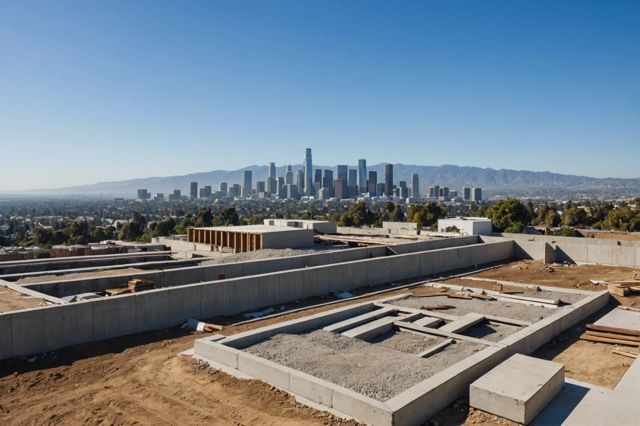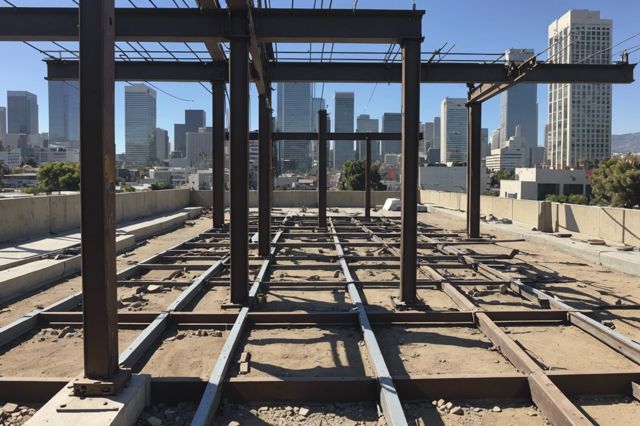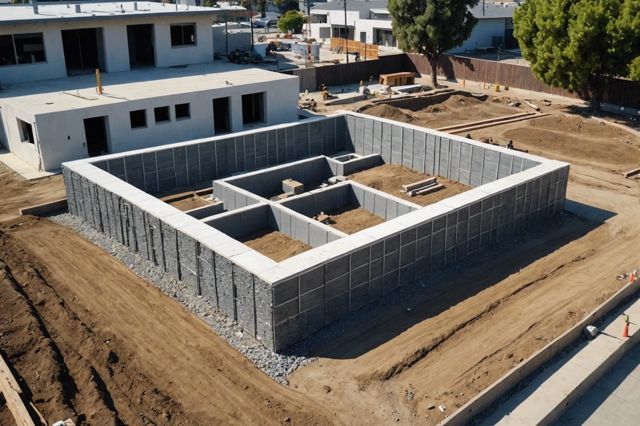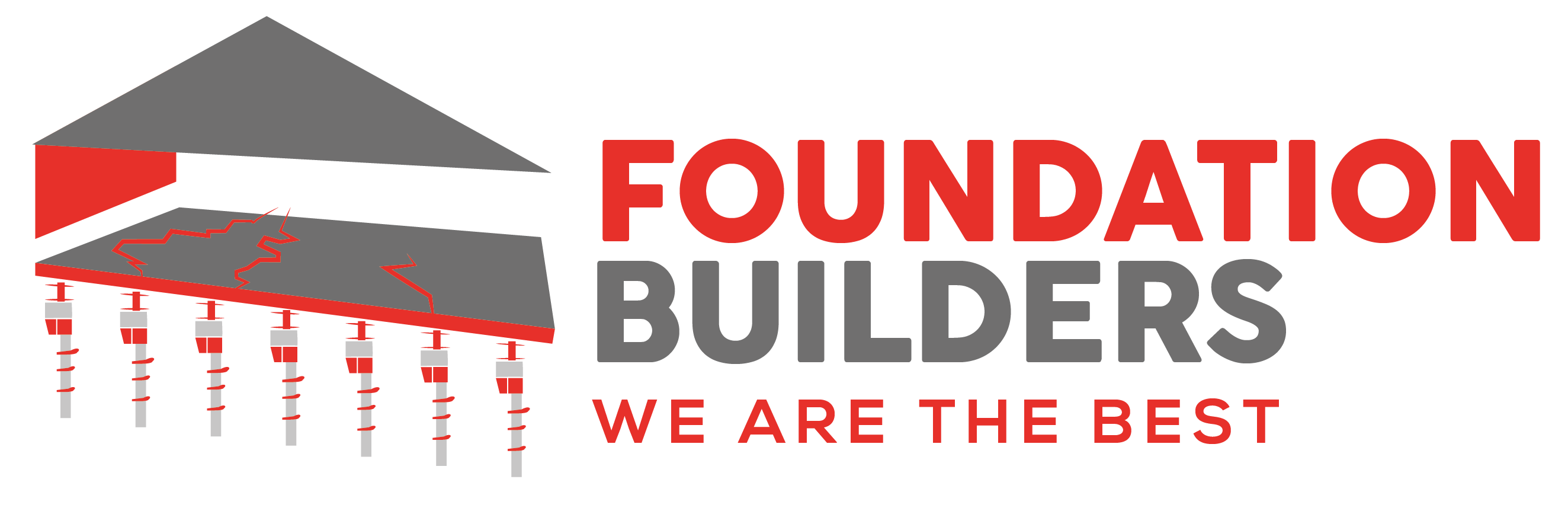Concrete and steel are the best materials for foundations in Los Angeles, offering structural strength and seismic resilience essential for the area’s unique climate and soil conditions. Concrete is versatile and durable, while steel provides flexibility and tensile strength, making them ideal for earthquake-prone regions.
Introduction to Foundations in Los Angeles
Choosing the right foundation material in Los Angeles is crucial due to the city’s unique climate and soil conditions. Here’s why:
- Climate Variability: LA experiences a range of weather conditions, from dry heat to heavy rains. This variability can affect how foundation materials react over time, making durability a key factor.
- Soil Composition: The region is known for its diverse soil types, including expansive clays which swell when wet and shrink when dry. This can lead to significant movement under your building if the foundation is not properly designed.
- Seismic Activity: Earthquakes are a reality in Southern California. Foundation materials and construction methods must be selected with seismic resilience in mind to protect structures from earthquake-induced damage.
- Local Building Codes: Adhering to the “Chapter 18A Soils and Foundations” from the CBC 2016 is mandatory. It covers critical topics such as:
- Geotechnical investigations to assess soil quality.
- Requirements for dampproofing and waterproofing to protect against moisture.
- Guidelines on load-bearing values of soils, which influence the choice of foundation type whether shallow or deep.
Understanding these factors helps in choosing the most appropriate and effective foundation materials for construction projects in Los Angeles, ensuring longevity and safety of the structures.

1. Concrete: The Preferred Choice for Durability
Concrete is a top choice for building foundations in Los Angeles due to its strength and ability to withstand earthquakes. It’s been a key material in construction for a long time, especially since the invention of reinforced concrete.
- Structural Lightweight Concrete (SLC): Offers great seismic resilience by being lighter, which lessens the load on structures and requires smaller support elements like beams and columns. This type of concrete has been used in major projects like the Benicia-Martinez Bridge and the expansion of Salt Lake City Airport.
- Benefits of SLC:
- Reduces the quantity of materials needed.
- Provides better insulation, leading to thinner, more energy-efficient floor slabs.
- Helps in creating sustainable buildings by reducing the overall carbon footprint.
Concrete’s versatility comes from its various forms: High-performance concrete, Self-compacting concrete, and Fiber-reinforced concrete.
These types are designed for specific needs and help in achieving durable, resilient foundations.
For homes in earthquake-prone areas, slab-on-grade foundations with turned-down footings are recommended. Key construction practices include:
- Using anchor bolts or approved connectors to attach house walls to foundations.
- Insulating foundations to meet thermal efficiency standards.
Proper mixing, placement, and curing of concrete are critical for the foundation’s strength and longevity. Modern advancements and sustainable practices are important for balancing the environmental impact of concrete production.
2. Steel: Enhancing Foundation Strength
- Steel is highly valued in foundation construction due to its tensile strength and flexibility. This makes it particularly suitable for areas like Los Angeles, which are prone to earthquakes.
- In Japan, where earthquakes are common, steel structures make up about 40% of new building floors each year. The choice of steel supports the buildings during severe quakes, despite its higher cost compared to materials like concrete and timber.
- Earthquake-resistant building techniques often involve steel. One method ties the foundation to the building, allowing both to move together during a quake. Another method, base isolation, uses systems like bearings and springs to let the foundation move independently, protecting the structure above.
- Steel’s ductility is crucial in earthquake zones. Unlike brick or concrete, steel can bend without breaking, offering greater safety during seismic activity. Engineers also use damping systems to reduce vibrations, further enhancing safety in steel-constructed buildings.

3. Innovative Composite Materials
In Los Angeles, the push for eco-friendly buildings is growing, and the foundation is a key focus. Traditional materials like concrete impact the environment negatively due to their energy-intensive production processes. Innovations in foundation materials are not only better for the environment but also suited to the unique climate and soil conditions of Los Angeles.
- Plastic Polymers: Utilizing recycled plastics, these materials are durable and innovative. They are used in structures like Structural Insulated Panels (SIPs) and Insulated Concrete Forms (ICFs), which help reduce energy costs significantly.
- Stone: As a natural and strong material, stone does not release harmful chemicals, making it an environmentally friendly option for foundations.
- Cob: Made from natural elements like straw, soil, and sand, cob is cost-effective and energy-efficient. However, it requires careful humidity control to prevent mold.
Explore more about innovative foundation solutions like Helical Piers and Foundation Replacement offered by our company. These services are designed to meet the needs of both commercial builders and residential homeowners, ensuring durability and sustainability in construction projects.

FAQ
What makes choosing the right foundation material crucial in Los Angeles?
Choosing the right foundation material in Los Angeles is crucial due to the city’s unique climate and soil conditions, which include variable weather, diverse soil types with expansive clays, frequent seismic activity, and stringent local building codes. These factors influence the effectiveness, longevity, and safety of the foundation in construction projects.
Why is concrete a preferred choice for building foundations in Los Angeles?
Concrete is preferred for its strength and resilience, particularly in earthquake-prone areas like Los Angeles. Its ability to withstand seismic forces makes it a fundamental choice in construction. Additionally, specific types of concrete, like Structural Lightweight Concrete (SLC), offer benefits such as earthquake resilience by being lighter, better insulation properties, and a reduction in overall carbon footprint.
How does steel enhance the strength of foundations in earthquake-prone areas?
Steel is highly valued in foundation construction for its tensil strength and flexibility, which are crucial in seismic zones. Steel can bend without breaking, offering greater safety during earthquakes. Earthquake-resistant techniques incorporating steel, such as tying the foundation to the building or using base isolation methods, enhance the building’s ability to withstand seismic activity.
What are some innovative foundation materials mentioned for eco-friendly building in Los Angeles?
Several innovative materials are highlighted for eco-friendly building, including plastic polymers from recycled plastics, natural stone, and cob (made from straw, soil, and sand). These materials not only meet the unique climate and soil conditions of Los Angeles but also reduce the environmental impact, contributing to more sustainable construction practices.
How are Helical Piers and Foundation Replacement significant for construction in Los Angeles?
Helical Piers and Foundation Replacement techniques are significant for construction in Los Angeles as they offer tailored solutions that enhance the durability and sustainability of projects. These methods are suitable for both commercial and residential buildings, meeting diverse needs and ensuring that buildings are capable of withstanding the region’s specific environmental conditions.

